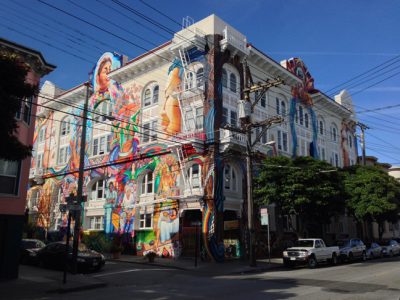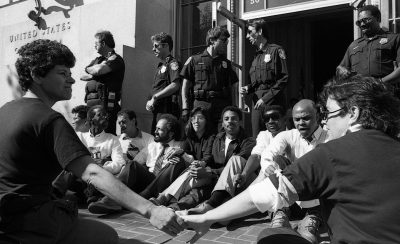In praise of multistory places
13 April 2017 – Donna Graves
Editor’s Note: This is the last of a series of posts reflecting on Gregory Rosenthal’s article, “Make Roanoke Queer Again: Community History and Urban Change in a Southern City,” published in the February 2017 issue of The Public Historian, and on how the Roanoke project relates to other LGBTQ public history projects.
Never again will a single story be told as though it’s the only one.
— John Berger, G.: A NovelThere is no such thing as a single-issue struggle, because we do not live single-issue lives.
— Audre Lorde, “Learning from the 60s”

Originally built as a German social hall, The Women’s Building in San Francisco’s Mission District has served as one of the anchors for women, feminists, lesbians, and queer and progressive groups more generally in San Francisco since it was founded in 1978. Photo credit: Paul Krueger Licensed under CC BY-NC 2.0
Gregory Rosenthal’s essay, “Make Roanoke Queer Again: Community History and Urban Change in a Southern City,” offers a valuable glimpse into the dimensions of reconstructing queer history in a small southern city. It also reminds me that the multiplicity and contestation embedded in John Berger’s and Audre Lorde’s words above apply to our work in public history and in historic preservation. I’d like to add a related epigraph to this blog post:
There is no such thing as a single-story place.
Rosenthal thoughtfully reflects on the accomplishments, challenges, and limitations of the new Southwest Virginia LGBTQ+ History Project and on the necessity of acknowledging multiple perspectives within that endeavor. Expanding perspectives on LGBTQ history beyond major metropolitan areas is important work and especially appreciated by practitioners like me who have been steeped in the better-known histories of queer urban America.
I recently spent several years collaborating with architectural historian Shayne Watson on a detailed study, Citywide Historic Context Statement for Lesbian, Gay, Bisexual, Transgender, and Queer History in San Francisco. In contrast to Rosenthal, we had the luxury of a grant to pursue our research, robust archival collections (that were still relatively weak in documenting experiences on LGBTQ people who were not white gay men), and active organizations whose members were eager to contribute to the project. These resources allowed us to document queer history not only in the expected Castro and Tenderloin neighborhoods, but to discover that LGBTQ history is woven into many neighborhoods and sites across the city.
I would suggest that the next phase of work in Roanoke go beyond the spatial types that Rosenthal and others appear to have indexed to date. In San Francisco, like Roanoke, bars played a central role historically as a place to find other LGBTQ people, and our study listed dozens of buildings that once held important bars and nightclubs. Likewise, the San Francisco study highlights the importance of public spaces such as parks and alleys for (primarily gay male) cruising.
Yet combating queer erasure will mean uncovering sites associated with a much wider range of stories and time periods. A 2001 article in the Washington Post named multiple LGBTQ organizations and businesses that were already well-established in Roanoke, including a congregation of the Metropolitan Community Church, chapters of Alcoholics Anonymous and Parents, Families and Friends of Lesbians and Gays (PFLAG), a queer bowling league, and a country dancing club. A horrendous shooting the previous year that targeted LGBTQ people inspired the Post article. The shooter was reportedly searching for a gay bar and was directed to the Park, which figures so powerfully in the memories of Rosenthal’s subjects, but happened upon Backstreet Café first. The assault left one person dead and six wounded. That site and its history are also worth remembering, as is the community vigil that followed.
Expanding the universe of places remembered and honored for their significance in LGBTQ history is an undeniably important task and one that has been supported at the highest levels with the recent publication of the National Park Service’s LGBTQ National Theme Study, a remarkable document that is part of NPS’s effort to achieve its goal of “telling all Americans’ stories” developed under the Obama administration. Under the leadership of Megan Springate, the theme study mandated that authors work to treat their individual topics with an intersectional lens that recognizes multiple axes of identity.
I am writing this in early January 2017 as the new federal administration is being formed, and am preoccupied with what it means to be an activist public historian at this moment. In addition to reclaiming histories that have been marginalized, suppressed, and actively obscured, we should consider how the histories we are lifting up align with others, and how they can move us forward in resisting the regressive elements of the Trump agenda.
Preservation and place-based public history projects can vividly illustrate intersectionality and the promise of coalition building. In San Francisco several such sites jump to mind. I am currently writing a National Register nomination for The Women’s Building, a community landmark that has foregrounded connections among and between the politics of gender, race, class, and sexuality from its founding in 1978 to the present. In the Tenderloin, a diverse coalition is working to develop an LGBTQ National Register Historic District nomination and an inclusive, trans-centered cultural district to protect historic sites and places important to contemporary daily life and cultural expression.

The AIDS/ARC Vigil was a round-the-clock encampment from 1985 to 1995 in front of the building housing the regional office of Health and Human Services in San Francisco’s Civic Center. Photo credit: ©Rick Gerharter.
One particularly resonant place that needs a strategy for recognition in this context is San Francisco’s Civic Center. Recognized as a National Historic Landmark District for its grand Beaux Arts buildings and urban design, the area holds powerful memories and meanings for countless Bay Area residents. As the place where residents can speak truth to local, state, and federal power, it has drawn activists to marches, rallies, demonstrations, performances, and sit-ins over many decades. In 1934, Civic Center hosted huge protests from the West Coast waterfront strike and in subsequent decades was the focus of important mass actions against wars and police brutality and for civil rights, disability rights, workers and immigrants rights, and many more social justice issues. For LGBTQ people, Civic Center retains memories of the White Night Riots after Dan White’s lenient sentence for assassinating Harvey Milk and George Moscone, of joyful Pride celebrations, and of myriad protests around the HIV/AIDS epidemic. I’ll confess that that last sentence is only a partial list and one shaped by my own political biases.
But I call on my fellow public historians to enlist artists and other collaborators to dream up projects that make vivid the power of our history of collective action, which has been enacted repeatedly in San Francisco and in civic centers across the country.
As Sarah Montoya, a graduate student at UCLA recently wrote in OutHistory, “To celebrate our existence is not enough, and our mobilization in the wake of a Trump regime means that coalition building is crucial.” Multistory places, especially those that illustrate moments when communities worked together to bend the arc of history toward justice, are especially important sites for public historians to turn their energies toward today.
Thanks go to teacher and Roanoke resident, Tom Landon, who directed me to several sources while I thought about this blog post.
~ Donna Graves is an independent historian/urban planner based in Berkeley, California. She develops interdisciplinary public history projects that emphasize social equity and sense of place. Recognitions for Graves’s work include the Vernacular Architecture Forum’s first Advocacy Award, the National Park Service’s Home Front Award, the California Preservation Foundation’s Trustees Award for Excellence in Historic Preservation, and the California Governor’s Historic Preservation Award. In 2009–10 Graves was a Loeb Fellow at Harvard University’s Graduate School of Design.



